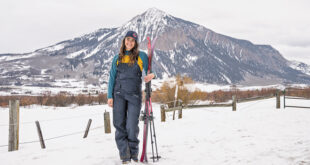On a hot summer day outside Paul Ehrlich’s cabin in Gothic, it’s serene and quiet, save for the birds and rustling leaves. Inside, it’s a scene of stacked papers and bags being packed for a trip. Among it all, there’s a deeper sense of urgency. Ehrlich, a Stanford professor and best-selling author, has spent the last 50 years warning people of an imminent threat to the relative stability we’ve all enjoyed on this planet. The early signs of consequential change are all around us. And still, no one is listening.
Ehrlich first gained widespread prominence for his predictions after the 1968 publication of his book The Population Bomb, which envisioned a future where the human race overruns earth’s resources and advocated for action to avoid an untimely end to civilization. Many of his predictions in the book turned out to be premature, but it sold 2 million copies and brought the issues related to overpopulation to a broad audience.
The book was only the beginning for Ehrlich, and it wasn’t enough. Like Reverend Malthus and the Paddock brothers, whose earlier warnings of a world with more people and less food had fallen on deaf ears, Ehrlich has spent decades addressing a problem few others will admit exists. But he is sure the threat is real, and compelling people to take action is a challenge he’s embraced wholeheartedly.
For his efforts, Ehrlich has received a long list of awards and accolades. In 1990, he was awarded the Crafoord Prize of the Royal Swedish Academy of Sciences, which is given to those people who work in fields not recognized by the Nobel Prize (astronomy and mathematics, biosciences, geosciences or polyarthritis research).
He’s a fellow of the American Association for the Advancement of Science, the American Academy of Arts and Sciences and the American Philosophical Society and a member of the National Academy of Sciences. The list goes on. At Stanford, where he’s been on the faculty for 53 years, he is the president of the Center for Conservation Biology as well as the Bing Professor of Population Studies. He even helped establish an entirely new field of study: coevolution.
And this summer, he was honored as a Fellow of the Royal Society for his “contribution to the improvement of natural knowledge,” although he missed his meeting with Queen Elizabeth II because of a delayed flight from the local airport.
But sitting in his cabin in Gothic, he doesn’t seem like a man who rides high on the awards he’s won or the titles he’s been given. He’s not content just to talk about all he knows. He needs someone to listen and to take action.
Ehrlich has always been one to get things done. When he arrived in the mostly abandoned silver-mining town of Gothic more than 50 years ago, he saw a lot of potential and not much else.
“You can’t imagine what this place was like when I came here in 1960. There were just ancient falling-down log cabins from the days of the silver explosion,” he says. “The streets weren’t paved in Crested Butte. There was Stefanic’s Market. There was one shit-kicking bar and that was damn near it. I don’t think there was a flush toilet at the Lab. And if you wanted to do your laundry you had to go to Gunnison to find a washing machine.”
Ehrlich carried water to his small cabin in milk pails and helped install the town’s first septic tank.
Since his first trip to the valley, Ehrlich has missed only two summers in Gothic, both while he was in Australia on sabbatical. His research, when he’s in town, isn’t necessarily focused on the global impacts of human activity. Mostly, his research in Gothic is focused on butterflies. “That’s my main research, although I’m no longer sprinting across talus slopes at 12,000 feet,” says Ehrlich, who turned 80 in May. “I’ve got to be careful about falling.”
Almost every day he’s around, he hikes two miles past Judd Falls to continue a survey he’s been doing on a transplanted species of European butterfly that he helped bring to the valley in 1977. “They’ve hung on by their wingtips for almost 40 years, occasionally exploding, and this year we found the biggest population where we released them originally, ever,” he says.
Ehrlich is tall and thin with slate grey eyes and a beard of graying stubble. After years of telling the other frogs in the pot that the water was getting warmer, and being largely ignored, he’s developed a cynical sense of humor and the matter-of-factness of someone with deep convictions.
He likes to write while he’s in town and conduct his research in the mountains behind the cabin. But the reality of more pressing issues, like climate change, is all around him and he can’t ignore it.
He points to a patch of snow clinging to the cliffs on Gothic Mountain. “I’ve never seen the Old Maid this small or separated,” he says. “Normally that whole area is filled in right now.” He says there are only a hundredth of the wildflowers in Gothic there normally are at that time. It’s just further evidence Ehrlich doesn’t need to know the world is changing in irreversible ways.
As far as Gothic is from Washington as the center of the political debate about climate change, it’s also right in the middle. “Some of the most important environmental scientists in the world are tied to this lab,” Ehrlich points out. “Obama’s science advisor, John Holdren, was among the first to teach an environmental studies course out here. We had Dick Lamb lecturing. We had John Levin, who was the county judge at the time, lecturing. John Harte’s stuff on climate change, David Inouye with the same kind of thing. I think one of the things that this area is beginning to recognize is that this place is a resource for the whole county, but also for the country and the world.”
The frustration, Ehrlich says, is that the evidence has mounted and it all points in the same direction: climate change. The facts and the figures are all in place, but the public still seems unconvinced thanks, in part, to a successful campaign being waged against science in the media and in certain political spheres. That success has given Ehrlich an idea.
“You look at the whole climate [change] denial thing, is a very well funded, anti-science movement that has been very successful. You’ve got to give them credit,” he says. “I’m a gun owner. But I think the second amendment was to keep your muzzleloader in the closet, not to let you keep a Glock on your belt. But you can see that 2 million people and the NRA have repeatedly, during my lifetime, put up with slaughter after slaughter after slaughter and managed to smash back down any attempt to invoke reasonable laws.”
Those examples of how a small group of people can influence the public’s willingness to support seemingly bad policy gives Ehrlich hope that the public can also be swayed to support good policies, if they’re engaged in the right way.
“My basic position, and that of most of my colleagues, is that we’ve figured out enough to know what the hell we should be doing,” he says. “So it’s an interesting issue of how you change people’s minds.”
He’s tried the straightforward approach, with logic and reason, but that had only minor success. “I used to be very pessimistic about what we will do and very optimistic about what we could do,” he says. “I’m no longer very optimistic about what we could do and that’s because you see it in the news every night that they’re not paying any attention to this.”
So now Ehrlich is looking for something new, something different. His search has led him away from his chosen field of study, biology, into something entirely different: sociology.
Ehrlich and several of his colleagues will be attending an American Sociological Association conference in Denver next month where an entire plenary session will be held on what Ehrlich calls the MAHB, the Millennium Alliance for Humanity and the Biosphere. (“Who doesn’t want to be a mobster?” he says.)
“It’s the consensus among my colleagues that, although finding out more science is important, the biggest single question we have is why in the hell isn’t anyone doing something about what the scientific community has been telling them for many years about the route we’re on and where it’s going to lead,” he says.
“I mean the situation is super-grim and nobody seems to be able to do anything about it. We all could have a sustainable society if we really started, on an emergency basis, doing the things most people think need to be done,” Ehrlich continues. “But it looks like a lot’s going to depend on luck.”
Check Also
Profile: Sarah Quinlivan
By Dawne Belloise They met on Match.com right after COVID was deemed to have …
 The Crested Butte News Serving the Gunnison Valley since 1999
The Crested Butte News Serving the Gunnison Valley since 1999



